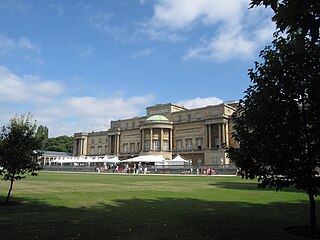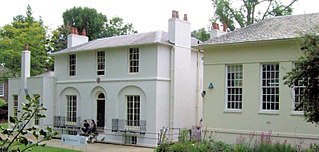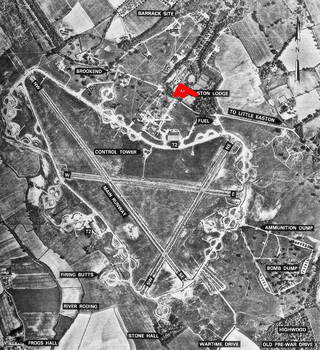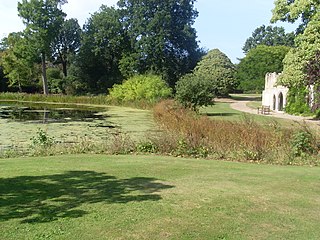
Milton's Cottage is a timber-framed 16th-century building in the Buckinghamshire village of Chalfont St Giles. It was the former home of writer John Milton, and is open to the public as a writer's house museum.

Milton's Cottage is a timber-framed 16th-century building in the Buckinghamshire village of Chalfont St Giles. It was the former home of writer John Milton, and is open to the public as a writer's house museum.
In 1665 Milton and his wife moved into the cottage to escape the Plague in London. Despite Milton's having spent less than a year at the cottage, it is important because of its being his only extant residence. While at the Grade I listed [1] 16th-century cottage, Milton completed his best known work, Paradise Lost ; the seeds for Paradise Regained were also sown here. Milton's friend Thomas Ellwood called the cottage "that pretty box in St. Giles".
The ground floor of the cottage is now a museum dedicated to Milton and his works. The four museum rooms contain the most extensive collection in the world on open display of 17th-century first editions of John Milton's works, both poetry and prose. Tours vividly describe and explore the extraordinary career of this blind genius in his refuge from the plague, where he wrote some of the finest poetry.

The cottage's garden is also open to the public and is planted in a traditional style.
In 1887, after an attempt was made to move the house to America and rebuild it there, a movement was begun locally to purchase the house by local public subscription. Queen Victoria opened the subscription list for the purchase of the Cottage in 1887. The Cottage and garden have been visited by Elizabeth II, Queen Elizabeth The Queen Mother, Princess Margaret, Countess of Snowdon, and Prince Richard, Duke of Gloucester, on separate occasions. To celebrate the quatercentenary of Milton's birth in 2008, Charles, Prince of Wales, and Camilla, Duchess of Cornwall, also visited.

Balmoral Castle is a large estate house in Aberdeenshire, Scotland, and a residence of the British royal family. It is near the village of Crathie, 9 miles (14 km) west of Ballater and 50 miles (80 km) west of Aberdeen.

Andrew Marvell was an English metaphysical poet, satirist and politician who sat in the House of Commons at various times between 1659 and 1678. During the Commonwealth period he was a colleague and friend of John Milton. His poems range from the love-song "To His Coy Mistress", to evocations of an aristocratic country house and garden in "Upon Appleton House" and "The Garden", the political address "An Horatian Ode upon Cromwell's Return from Ireland", and the later personal and political satires "Flecknoe" and "The Character of Holland".

Osborne House is a former royal residence in East Cowes, Isle of Wight, United Kingdom. The house was built between 1845 and 1851 for Queen Victoria and Prince Albert as a summer home and rural retreat. Albert designed the house himself, in the style of an Italian Renaissance palazzo. The builder was Thomas Cubitt, the London architect and builder whose company built the main facade of Buckingham Palace for the royal couple in 1847. An earlier smaller house on the Osborne site was demolished to make way for the new and far larger house, though the original entrance portico survives as the main gateway to the walled garden.

Marlborough House, a Grade I listed mansion on The Mall in St James's, City of Westminster, London, is the headquarters of the Commonwealth of Nations and the seat of the Commonwealth Secretariat. It is adjacent to St James's Palace.
This article contains information about the literary events and publications of 1667.

Sudeley Castle is a Grade I listed castle in the parish of Sudeley, in the Cotswolds, near to the medieval market town of Winchcombe, Gloucestershire, England. The castle has 10 notable gardens covering some 15 acres within a 1,200-acre estate nestled within the Cotswold hills.

Chalfont St Giles is a village and civil parish in southeast Buckinghamshire, England. It is in a group of villages called The Chalfonts, which also includes Chalfont St Peter and Little Chalfont.

Buckingham Palace Garden is a large private park attached to the London residence of the British monarch. It is situated to the rear (west) of Buckingham Palace, occupying a 17-hectare (42-acre) site in the City of Westminster and forms the largest private garden in London. It is bounded by Constitution Hill to the north, Hyde Park Corner to the west, Grosvenor Place to the south-west, and the Royal Mews, Queen's Gallery, and Buckingham Palace itself to the south and east.

Frogmore is an estate within the Home Park, adjoining Windsor Castle, in Berkshire, England. It comprises 33 acres (130,000 m2), of primarily private gardens managed by the Crown Estate. It is the location of Frogmore House, a royal retreat, and Frogmore Cottage. The name derives from the preponderance of frogs which have always lived in this low-lying and marshy area near the River Thames. This area is part of the local flood plain. Its large landscaped gardens are Grade I listed on the Register of Historic Parks and Gardens.

The London Charterhouse is a historic complex of buildings in Farringdon, London, dating back to the 14th century. It occupies land to the north of Charterhouse Square, and lies within the London Borough of Islington. It was originally built a Carthusian priory, founded in 1371 on the site of a Black Death burial ground. Following the priory's dissolution in 1537, it was rebuilt from 1545 onwards to become one of the great courtyard houses of Tudor London. In 1611, the property was bought by Thomas Sutton, a businessman and "the wealthiest commoner in England", who established a school for the young and an almshouse for the old. The almshouse remains in occupation today, while the school was re-located in 1872 to Godalming, Surrey.

Sandringham House is a country house in the parish of Sandringham, Norfolk, England. It is one of the royal residences of Charles III, whose grandfather, George VI, and great-grandfather, George V, both died there. The house stands in a 20,000-acre (8,100 ha) estate in the Norfolk Coast Area of Outstanding Natural Beauty. The house is listed as Grade II* and the landscaped gardens, park and woodlands are on the National Register of Historic Parks and Gardens.

Royal Lodge is a Grade II listed house in Windsor Great Park in Berkshire, England, half a mile north of Cumberland Lodge and 3.2 miles (5.1 km) south of Windsor Castle. Part of the Crown Estate, it was the Windsor residence of Queen Elizabeth The Queen Mother from 1952 until she died there in 2002, at the age of 101. In 2004 it became the official country residence of Prince Andrew, Duke of York, and his family. In 2023 it was reported that Andrew had been offered the smaller five-bedroom Frogmore Cottage instead, until then the UK residence of Prince Harry, Duke of Sussex and his family, who were requested to vacate by Buckingham Palace.

Keats House is a writer's house museum in what was once the home of the Romantic poet John Keats. It is in Keats Grove, Hampstead, toward the edge of inner north London. Maps before about 1915 show the road with one of its earlier names, John Street; the road has also been known as Albion Grove. The building was originally a pair of semi-detached houses known as "Wentworth Place". John Keats lodged in one of them with his friend Charles Brown from December 1818 to May 1820, and then in the other half of the house with the Brawne family from August to September 1820. These were perhaps Keats's most productive years. According to Brown, "Ode to a Nightingale" was written under a plum tree in the garden.

Guildford Museum is the main museum in the town of Guildford, Surrey, England. The museum is on Quarry Street, a narrow road lined by pre-1900 cottages running just off the pedestrianised High Street. This main site of the museum forms the gatehouse and annex of Guildford Castle, which the staff help to run. It is run by Guildford Borough Council and has free entry between 11am and 4:45pm on Monday to Saturday. It is closed on Sundays and on Christmas Day.

Coleridge Cottage is a cottage situated in Nether Stowey, Bridgwater, Somerset, England. It is a grade II* listed building. The 17th century cottage was originally two buildings which were later combined and expanded.

Ravenscourt Park or RCP is an 8.3 hectares public park and garden located in the London Borough of Hammersmith and Fulham, England. It is one of the Borough's flagship parks, having won a Green Flag Award. Stamford Brook and Ravenscourt Park tube stations are close by.

Easton Lodge was a Victorian Gothic style stately home in Little Easton and north-west of Great Dunmow, Essex, England. Once famous for its weekend society gatherings frequented by the Prince of Wales, it was one of many country houses destroyed during the 20th century. Part of the west wing still stands; and the Grade II listed gardens designed by Harold Peto are under restoration and opened to the public.

Shotover Park is an 18th-century country house and park near Wheatley, Oxfordshire, England. The house, garden and parkland are Grade I-listed with English Heritage, and 18 additional structures on the property are also listed. Shotover House, its gardens, parkland and the wider estate are privately owned by the Shotover Trust. Shotover Park which lies on the north and east slopes of Shotover hill should not be confused with the more recently named Shotover Country Park, which is a public park and nature reserve on the southwest slopes of Shotover hill managed by Oxford City Council.
Queen Charlotte's Cottage is an 18th-century cottage orné within the grounds of Kew Gardens on the banks of the River Thames in London. It is named after Queen Charlotte, who was responsible for its construction. Dating from 1772, the cottage is Grade II* listed. The cottage is maintained by Historic Royal Palaces, and is open to visitors.

The Gothic Ruin is located at Frogmore, in the Home Park of Windsor Castle, in Berkshire, England. Designed by James Wyatt in the late 18th century, the structure is a folly, comprising a summer house enveloped in the trappings of a Gothic ruin. It is a Grade II* listed structure.